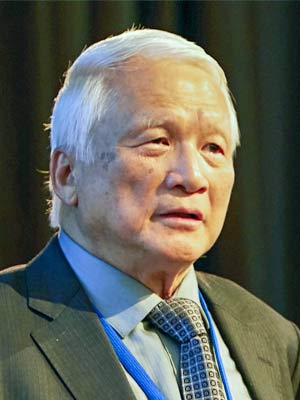John Chiang, Ph.D., FAASLD

Contact
Phone: 330.325.6694
Email: jchiang@neomed.edu
Office
Room: F-201
Publications
View publications
Google Scholar
Academic Title(s)
- Distinguished University Professor
- Professor of Integrative Medical Sciences
Bio
Dr. Chiang graduated from National Chung-shin University in Taiwan in 1969. In 1970, he came to the US to study his Ph.D. under Professor T. E. King at State University of New York at Albany.
From 1976-1978, he was awarded a National Research Service Award to study cytochrome P450 drug metabolism in Professor M.J. Coon’s lab at University of Michigan Medical School in Ann Arbor, MI.
In 1978, he became an assistant professor at Northeast Ohio Medical University (NEOMED). He was promoted to the rank of full professor in 1988.
He received many awards including Faculty Research Award, Liebelt/Wheeler Award for Faculty Excellence, Lifetime Achievement Award, MERIT Award of NIDDK, NIH, and Fellow of AASLD. He is the first Distinguished University Professor at NEOMED. He is serving on the editorial board of Hepatology, Hepatology Communication, Gene Expression, and Executive Associate Editor of Liver Research. He published over 180 manuscripts and earned 8 U.S. patents.
In December 2022, he was named professor emeritus.
Area of Expertise/Research Interests
Professor John Chiang’s lab purified and cloned the gene of cholesterol 7-hydroxylase (CYP7A1) in bile acid synthesis in hepatocytes. He studied the molecular mechanisms of bile acid feedback regulation of CYP7A1 transcription by nuclear receptors and transcription factors. His original research lead to the identification of bile acid-activated nuclear receptor FXR and the gut to liver axis in regulation of bile acid synthesis. His current research projects are focused on the role and mechanism of FXR and TGR5 signaling in regulation of bile acid, glucose, lipid and energy metabolism in non-alcoholic fatty liver disease, obesity and diabetes, and therapeutic treatments. His research projects have been funded continuously by NIH grants for over 33 years and received a MERIT award from NIDDK, NIH. He is an editor of Hepatology, Hepatology Communications and Gene Expression, and Executive Associate editor of Liver Research. He has published over 180 manuscripts and earned 8 U.S. patents.
Educational Background
- BS. Food Sciences (1969): National Chung-Shing University, Taichung, Taiwan.
- Ph.D. Chemistry (1976): State University of New York at Albany, NY.
- Postdoc (1976-1978), Biological Chemistry: University of Michigan Medical Center, Ann Arbor, MI.
- Assistant Professor, NEOMED, 1978
- Associate Professor, NEOMED, 1983
- Professor, NEOMED, 1988-present
- Distinguished University Professor, NEOMED, 2013-present.
- Graduate faculty member, Cellular and Molecular Biology, Pharmacology Program Committees, Kent State University, 1978-present.
Courses
- Molecular Pathology, Molecules to Cells
Academic & Professional Activities
- NIH study sections: Biochemistry, Hepatobiliary pathobiology
- Editorial Board: Journal Biological Chemistry, Hepatology, Hepatology Communication, Gene Expression
- Executive Associate Editor: Liver Research
- Membership: American Associate for Study of Liver Disease; American Society of Biochemistry and Molecular Biology; American Society of Pharmacology and Experimental Therapy; American Gastroenterology Association
- External Advisory Board of COBRE, University of Kansas Medical Center
Awards
- R37DK58379
- R01DK44442
- Faculty Research Award
- Faculty Excellence Award
- Lifetime Achievement Award
Distinctions
- Distinguished University of Professor, NEOMED
- Fellow of AASLD
Presentations
- Bile acid signaling crosstalk in gut and liver metabolism and therapy. 40th Kern Lipid Conference, Vail, Co., August 7-9, 2017.
- Bile acid and gut microbiota in NAFLD. International Conference on Diabetes and Metabolism, Seoul, Korea, October 11-13, 2018.
- Bile acid synthesis in obesity. Obesity week 2018, Nashville, TN, Nov 11-15, 2018.
- Activation of intestinal FXR induces TGR5 expression and stimulates GLP-1 secretion to ameliorate metabolic disorders in diabetic mice. Falk Symposium 203, June 17-18, 2016, Dusseldorf, Germany.
- 119. Bile acid metabolism, gut microbiota and NAFLD. AASLD annual meeting, Boston, MA. November 8, 2019
PUBLICATIONS
- Pathak, P., Liu, H., Boehme, S., Xie, C., Krausz, K. W., Gonzalez, F., and Chiang, JY. Farnesoid X Receptor and Takeda G-protein receptor 5 Crosstalk to Regulate Bile Acid Synthesis and Hepatic Metabolism. J Biol. Chem. 2017; 292: 11055-11069.
- Pathak, P., Xie, C., Nichols, RG., Ferrell, JM, Boehme, S., Krausz, K., Patterson, A., Gonzalez, FJ. and Chiang JYL. Intestine farnesoid X receptor agonist shapes the gut microbiota to activate G-protein bile acid receptor-1 signaling to improve metabolism. Hepatology 2018, 68: 1574-1588.
- Chiang, JYL, Ferrell, JM. Bile acids as metabolic regulators and nutrient sensors. Ann Rev Nutrition, 2019; 39:175-200.
- Ferrell, JM., Pathak, P., Boehme,S., Gilliland, T., and Chiang, JYL. Deficiency of both farnesoid X receptor and Takeda G coupled protein receptor 5 exacerbated liver fibrosis in mice. Hepatology, 2019; 70:955-970.
- Chiang, JYL., Ferrell, JM. Bile acid receptor FXR and TGR5 signaling in fatty liver diseases and therapy. American J. of Physiology: Liver and biliary physiology/pathophysiology, 2020; 318: G554-G573;


